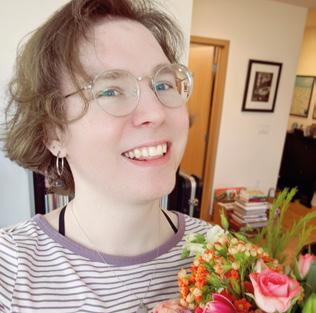
12 minute read
Meet the Maker: Thea Flowers
REGULAR
Making music one bit at a time
Modular synths are an endlessly
fascinating wormhole of weird
sound. Devotees will obsess over what, to our barbarian ears, are just endless versions of the same thing, in a way that’s completely cool and endearing. It’s a world of enthusiasts making things they love – one of whom is Thea
Flowers. Thea’s been making modular synths under the Winterbloom banner for three years now, and anyone with any musical taste will instantly recognise the classic sounds that her stuff makes.
What’s more, everything she does is open-source.
“I got into modular synths because of electronics.
I’ve been playing music most of my life now, and I’ve always liked synthesisers and the idea of them, but I’ve never really got into modular synthesisers. I heard about modular synths a few years ago, and my immediate reaction was ‘that’s not something that I want to do’. However, when I started getting into electronics, I was building custom keyboards, mechanical keyboards, and stuff like that. I did music and I wanted to explore standalone synthesizers.
“The idea of building a standalone synthesiser by yourself is daunting; you have to do so much. So
I started looking for a way to build synthesisers without having to know everything out of the gate, to build a full synthesiser entirely by myself. I started to look back into the modular stuff and saw like, this is actually really awesome. There’s so much neat stuff going on, so many unique little modules – this is perfect! I can experiment, I can play around with stuff, I can make tiny single-purpose things that don’t require me to have a PhD before I even start creating things.
“It was more about the desire to create something physical than the desire to create music. It’s the tinkering aspect – I like the idea of small singlepurpose machines that work together.
“My first module is called Sol, and it’s a MIDI-tocontrol voltage (CV) model. In the world of modular synthesisers, everything talks to each other using CV; in the world of computers, everything talks to each other using MIDI. Sol is the bridge between the two. You can hook it up to your computer and send it MIDI notes – Sol will convert that to CV.
“What’s cool about Sol is that it’s running CircuitPython. You can change how it translates MIDI information to CV. You can make it do all kinds of neat stuff. Instead of outputting a note, you can make it output a note plus some vibrato; you can make it change the scale of the note. You can also make it play the role of smoother modules that you may not have if you’re just starting out. It can be an envelope generator, it can be a little frequency oscillator if you want it to do that. Sol is really customisable and it’s a little reprogrammable brain that can process MIDI and spit out CV.
“Big Honking Button is technically a sampler with a button on it, and when you press the button, it honks. It also runs CircuitPython, and it’s customisable, so you can make it do all kinds of cool stuff. For example, there are samples on there for doing percussion. One of my favourites that I wrote is a cycle program, so you tell it a list of samples, and every time you press the button, it will cycle through them. You can have a drum sound and
Right The Big Honking Button: a reprogrammable, open sampler, running CircuitPython SPARK
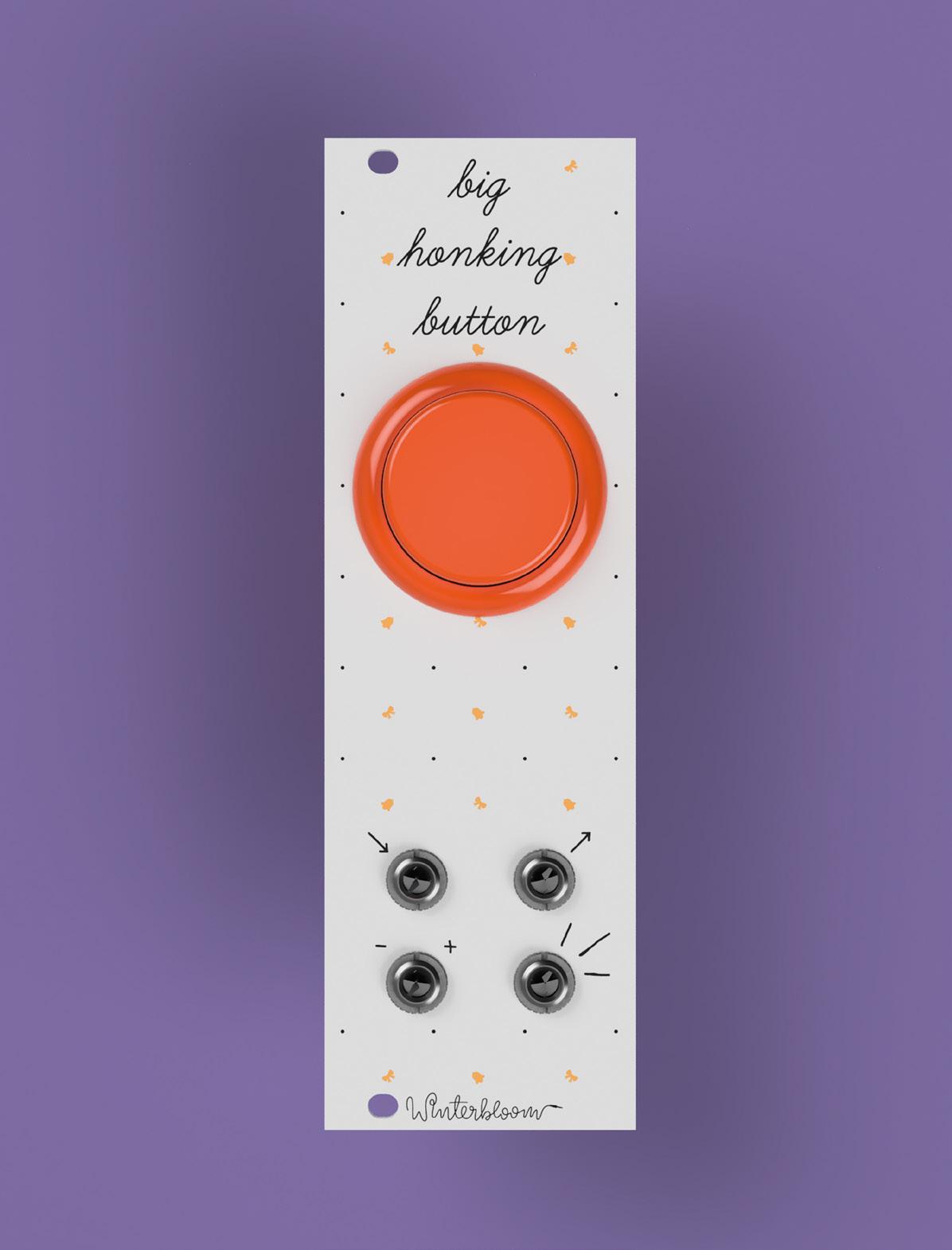
Right Thea was inspired to create a synthesizer by her lifelong love of the music on Sega Genesis [aka Megadrive] games

SPARK
a snare sound, and alternate between them every time you hit the button.
“The thing I’m working on at the moment is called Castor & Pollux – it’s my favourite module that I’ve designed so far. It’s beautiful. It’s the module that I’ve wanted to make since I started making modules. It’s a Roland JUNO-inspired oscillator. It basically brings the voice that the Roland JUNO had into the Eurorack form. That voice is legendary; it’s built into everything. You could throw a rock at the 1980s and hit 17 songs that had the JUNO on them.
“It was the first polysynth that could stay in tune. Every other synth at the time used a lot of analogue circuitry that was all temperature-dependent. It would be out of tune when you got on stage, and by the time you’d fixed the tuning and started playing, 15 minutes later it would be out of tune again because it had warmed up a bit.
STAY TUNED!
“The Roland JUNO took a different approach, and because of that, it stayed in tune. You could plug it in and it would be good to go. It got a lot of popularity because of that, and also because of the way that it sounds. It’s in so many songs; Cyndi Lauper’s breakout album, Time After Time, that’s all the JUNO; a-ha’s Take On Me, that’s the JUNO; Sweet Dreams by the Eurythmics, that really awesome intro, that’s the JUNO. It’s so perfect. I wanted to bring that voice to Eurorack.
“This has actually been done before – someone straight up took the oscillator design and put it into Eurorack, and that’s awesome. I wanted to do something a little bit weird, though. I decided to take two of them. This is actually two oscillators that are based on the JUNO oscillator, so it can overcook some of the limitations that were in the original JUNO design. Because the JUNO only has one oscillator per voice, it sounds a little thin sometimes. The way that Roland got around this was by adding chorus to the end of it to make it a little bit thicker.
“But Castor & Pollux actually has two complete oscillators that are independent and can be configured to follow each other. That gives you the ability to stack detuned oscillators together to create these massive-sounding voices that just weren’t possible on the JUNO. It’s inspired by the JUNO, it sounds a lot like the JUNO, but it also has its own unique voice that just wasn’t possible on the JUNO, and I really love that.
“Big Honking Button got way more popular than I ever expected. I expected that people would get it and they’d immediately change the sample that’s on it. It’s designed to do that. It’s supposed to be silly to draw you in, but then you realise that you can get it to play any sample you want just by hooking up a USB cable and swapping out the sample. You can also change the code on it because it’s CircuitPython.
“However, there are a lot of people who bought two of them and left one of them as the honk – the default program, the link sound. People send me videos of themselves all the time using this honk in otherwise straight-up awesome music. I never anticipated Big Honking Button to be what it is. It’s
silly; I love it. At least from a creative perspective, Castor & Pollux is the module I had in my brain when I started doing this. To see it become a thing, and the reception that it’s had so far, is incredible. It’s become a lot bigger than I’ve anticipated, and a lot bigger than anything else I’ve done.
“We’ve just sold out the pre-order for the first run. I’m working with our contract manufacturer to do a second run. That’s really exciting. I’ve never done
Below Just some of the sell-out first run of Castor and Pollux – it’s like the Roland Juno, but twice as good
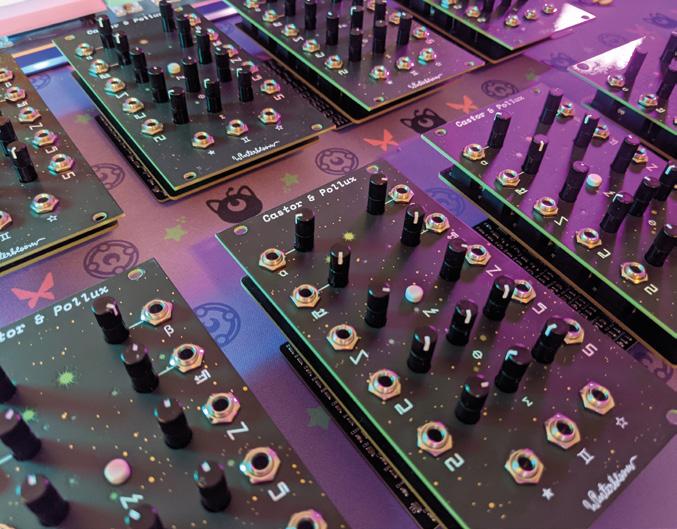
REGULAR
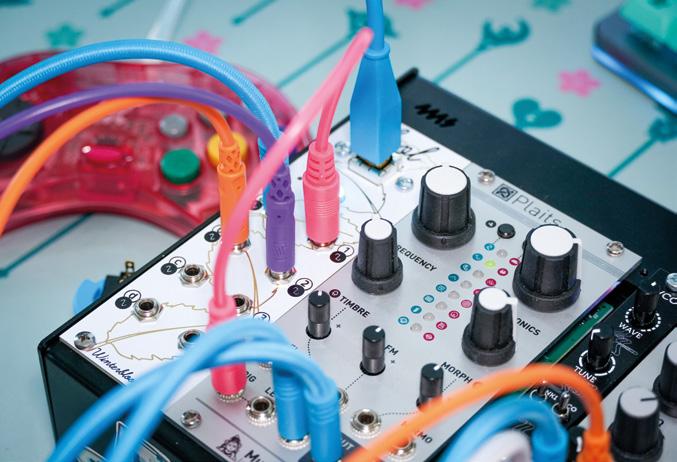
Above Sol, Thea’s first module, converts MIDI input into control voltage
Right Thea’s products all conform to the Eurorack form factor – the gold standard of modular synths
anything where it sells out before I’ve even shipped the first one! I’m really happy about it. It’s less ‘coping’, and more ‘being really excited’ and trying to maintain the high level of quality that I have for everything. The first run was 150, and we’ve sold every single one of them. “There’s a mix of ” people. There are certain demographics of people who are into Eurorack synthesizers, right? People who have disposable income and who are technically inclined. I’ll also say I’m really happy that some of my first supporters and biggest customers are friends of mine that are part of a transgender Discord.
“These people have watched me take Castor & Pollux from a circuit on a breadboard to a finished product, and their support is so important to me. They’re repeat customers; they give me great feedback, and they really make feel like I’m part of a community versus making a product that some people are buying. It’s collaborative in a huge way to send over some sound samples and have them give me feedback so that I can iterate on that. “There’s a lot of wealthy white dudes in Eurorack; there’s also a huge part of it that is people who aren’t necessarily rich with disposable income, and I’m glad that my customers come from a mix of both. It’s important to me that I make modules that are approachable and obtainable. If every module I made was $600 and I was only selling to ridiculously wealthy people, I would not be happy about that. It’s a mix of people – I’m happy about that. “Because we don’t have distributors outside of the US now, it’s mostly US-focused, but we do get quite a lot of orders from the UK and Australia, which is really cool. I would love to be able to ship to them more cheaply. We are talking to two different distributors in the UK, and hopefully that’ll work out. “Everything I do in terms of Winterbloom is
The point isn’t that I’m open-source. From the making synth modules. It’s hardware design to the bill of materials to that I’m making things that the firmware, to the people use to learn ” factory setup scripts that we have for each module, everything is open-source. “Some people will copy the work, and I want them to. I want to see people do that. I’m happy when that happens. That’s part of the point. But from what I’ve noticed, people are willing to pay for you to create something for various reasons. It could be the convenience of having it built for them, or the assurance that someone who knows what they’re doing put it together, or it could just be that they want to support you and want to give you money so you’ll continue to do what you do. “I put my stuff out there as open-source, and I’m not bothered if someone wants to go and take it and make it themselves. “The point isn’t that I’m making synth modules. It’s that I’m making things that people use to learn. The education piece is the most important piece to me. I want my modules to be fun, but I also want my modules to be educational in some way. You can see that throughout everything I do. You can take Castor & Pollux as a user guide, and in many ways, it’s an introduction to what synthesis is.
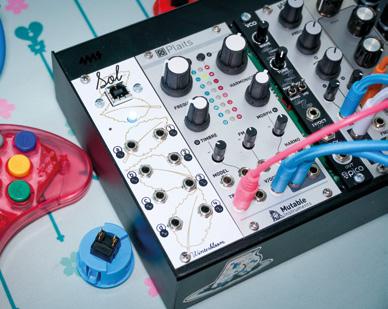
“I owe my entire career to open-source. I didn’t go to college, so in terms of learning how to program, and learning how to do all this stuff, it’s all because other people decided to make stuff open-source, so that I could learn from it. It feels like an obligation, but also I have a huge desire to give back.
COMMUNITY IS KEY
“You can’t develop a module in a vacuum, right. You can’t develop something that’s designed to work with other pieces of equipment if you have no idea what other people are going to use it for. A lot of the feedback I got from Castor & Pollux was around the controls on the front of it. I got really good feedback on tuning it; people were concerned about these little trimpots on here. Because it is a little hard to nail the exact setting on something that small. Based on that feedback, I made a little edit in software to make the tuning knobs non-linear so that the centre of the range is more spread out, so you have an easier time dialling in the note that you want. It’s little things like that, quality of life, that I get from the community.
“[Before getting into hardware] I had been a software engineer for over a decade. I mostly focused on the Python community, developer tooling, and APIs and stuff like that. I’m a Python Software Foundation fellow, so I’ve done a little bit in the Python community.
“I’m relatively new to the hardware world. I’ve been really happy with how, over the last three years or so, PCB prototypes, and, even small-scale contract manufacturing, have become so much more accessible to people. If it weren’t for contract manufacturers willing to do small runs of things, if it weren’t for PCB services like OSH Park and others, I couldn’t even do this. It would be impossible.
“People ask me all the time, ‘how do I get into doing hardware stuff?’ And the best answer I have is: find a community. Go and seek out people who are doing things that you want to do – surround yourself with those people. Having a community is the best way you’re going to learn, and the best way you’re going to be successful. You need people to interact and learn from and share with. That is the most important thing you can do. You can not learn any of this stuff in a vacuum.
“I could not have done this without the modular synth communities I’ve been a part of, and the Adafruit community. Scott Shawcroft, the CircuitPython project lead, once spent like four hours helping me debug the first board that I had designed. He didn’t have to do that, but he did. Community is essential.”

Right The best way to learn a new thing is to find a community – luckily, Open Source Hardware people tend to be willing to share their knowledge SPARK
ONLY £10
THE BEST PROJECTS FROM HACKSPACE MAGAZINE











